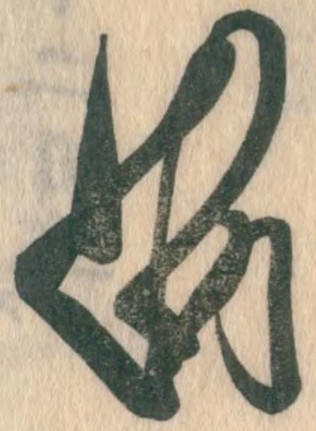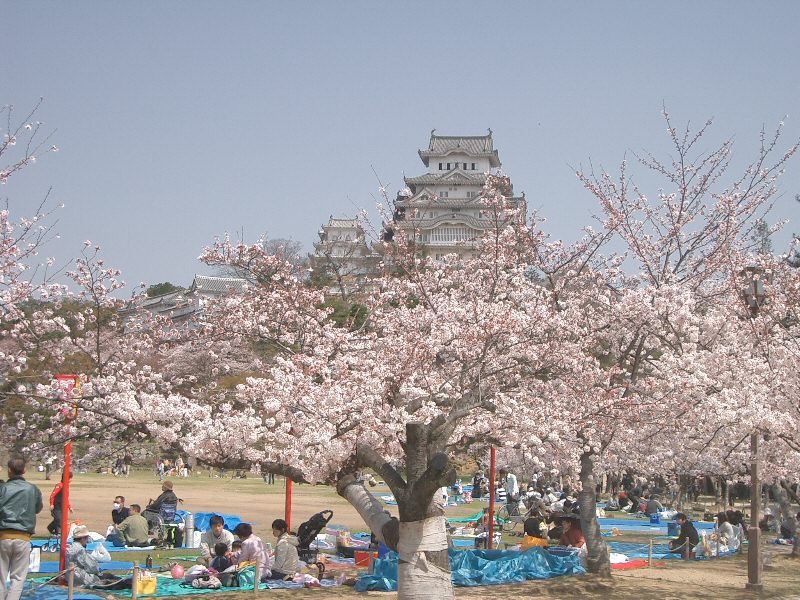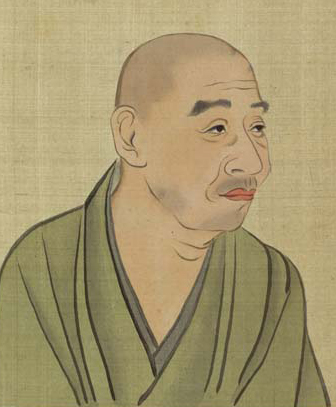|
Kurama-tengu
is a Noh play from the fifteenth century, concerned with the childhood experiences of the samurai hero Minamoto no Yoshitsune. Plot The play begins with a cherry blossom viewing expedition involving monks and children from Kurama temple. On being joined by a rough Yamabushi - an ascetic mountain priest - the party leaves in protest, with the exception of one child, who reveals himself as the young Yoshitsune, isolated at the temple both as an orphaned son and as the only child from the (eclipsed) Genji clan. The stranger reveals himself in turn as the head Tengu, or long-nosed goblin; and he proceeds to instruct the young hero in the martial arts, with a view to him avenging his slaughtered father's death. Characteristics *The play is notable for the large cast of child actors, and for the range of actions - chanting; acting; swordplay - which they undertake. *Critics have seen elements of homoeroticism in the relationship between the (phallicized) Yamabushi and the child a ... [...More Info...] [...Related Items...] OR: [Wikipedia] [Google] [Baidu] |
Sōjōbō
In Japanese folklore and mythology, is the mythical king and god of the ''tengu'', legendary creatures thought to inhabit the mountains and forests of Japan. Sōjōbō is a specific type of ''tengu'' called ''daitengu'' and has the appearance of a yamabushi, a Japanese mountain hermit. ''Daitengu'' have a primarily human form with some bird-like features such as wings and claws. The other distinctive physical characteristics of Sōjōbō include his long, white hair and unnaturally long nose. Sōjōbō is said to live on Mount Kurama. He rules over the other ''tengu'' that inhabit Mount Kurama in addition to all the other ''tengu'' in Japan. He is extremely powerful, and one legend says he has the strength of 1,000 normal ''tengu''. Sōjōbō is perhaps best known for the legend of his teaching the warrior Minamoto no Yoshitsune (then known by his childhood name Ushiwaka-maru or Shanao) the arts of swordsmanship, tactics, and magic. Etymology Most ''tengu'' are referred to ... [...More Info...] [...Related Items...] OR: [Wikipedia] [Google] [Baidu] |
Tengu
are a type of legendary creature found in Japanese folk religion (Shinto). They are considered a type of ''yōkai'' (supernatural beings) or Shinto ''kami'' (gods). The ''Tengu'' were originally thought to take the forms of birds of prey and a monkey deity, and they are traditionally depicted with human, monkey, and avian characteristics. Sarutahiko Ōkami is considered to be the original model of Konoha-Tengu (a supernatural creature with a red face and long nose), which today is widely considered the ''Tengu''s defining characteristic in the popular imagination. He is the Shinto monkey deity who is said to shed light on heaven and earth. Some experts theorize that Sarutahiko was a sun god worshiped in the Ise region prior to the popularization of Amaterasu. Buddhism long held that the ''Tengu'' were disruptive demons and harbingers of war. Their image gradually softened, however, into one of protective and even manifestations of Buddhist deities, if still dangerous, spirits ... [...More Info...] [...Related Items...] OR: [Wikipedia] [Google] [Baidu] |
Minamoto No Yoshitsune
was a military commander of the Minamoto clan of Japan in the late Heian and early Kamakura periods. During the Genpei War, he led a series of battles which toppled the Ise-Heishi branch of the Taira clan, helping his half-brother Yoritomo consolidate power. He is considered one of the greatest and the most popular warriors of his era, and one of the most famous samurai in the history of Japan. Yoshitsune perished after being betrayed by the son of a trusted ally. Early life Yoshitsune was the ninth son of Minamoto no Yoshitomo, and the third and final son and child that Yoshitomo would father with Tokiwa Gozen. Yoshitsune's older half-brother Minamoto no Yoritomo (the third son of Yoshitomo) would go on to establish the Kamakura shogunate. Yoshitsune's name in childhood was Ushiwakamaru or ''young bull'' (). He was born just before the Heiji Rebellion in 1160 in which his father and two oldest brothers were killed. He survived this incident by fleeing the capital with his ... [...More Info...] [...Related Items...] OR: [Wikipedia] [Google] [Baidu] |
Kurama Tengu (Nōgaku Hyakuban) By Tsukioka Kōgyo (National Noh Theatre)
Kurama may refer to: Japan * Mount Kurama, a mountain in Japan frequently referenced in martial arts * Kurama-dera, a temple * Japanese armored cruiser ''Kurama'', an ''Ibuki'' class armored cruiser (later battlecruiser) named after Mount Kurama * JDS ''Kurama'' (DDH-144), a ''Shirane'' class destroyer * Kurama Tatsuya (1952–1995), sumo wrestler Fictional characters * Kurama (''Naruto''), a character in ''Naruto'' media **Kurama clan members, Naruto anime only arc * Kurama (''Urusei Yatsura''), a character in ''Urusei Yatsura'' media * Kurama (''YuYu Hakusho''), a character in ''YuYu Hakusho'' media * Kurama, a character in ''Elfen Lied'' media Other uses * Kurama Range, mountains near Angren, Uzbekistan * ''Kurama'' (moth), a genus of moths of the family Drepanidae * Kurama language The Kurama or T'kurmi or Akurmi language is a Kainji language of Nigeria. Kurama speakers are found in the central northern Nigerian states of Kaduna, Bauchi, Borno, Kano, Jigawa ... [...More Info...] [...Related Items...] OR: [Wikipedia] [Google] [Baidu] |
Hanami
is the Japanese traditional custom of enjoying the transient beauty of flowers; in this case almost always refer to those of the or, less frequently, trees. From the end of March to early May, cherry trees bloom all over Japan, and around the first of February on the island of Okinawa. The is announced each year by the Japan Meteorological Agency, and is watched carefully by those planning ''hanami'' as the blossoms only last a week or two. In modern-day Japan, ''hanami'' mostly consists of having an outdoor party beneath the sakura during daytime or at night. In some contexts the Sino-Japanese term is used instead, particularly for festivals. ''Hanami'' at night is called . In many places such as Ueno Park temporary paper lanterns are hung for the purpose of ''yozakura''. On the island of Okinawa, decorative electric lanterns are hung in the trees for evening enjoyment, such as on the trees ascending Mt. Yae, near Motobu Town, or at the Nakijin Castle. A more ancien ... [...More Info...] [...Related Items...] OR: [Wikipedia] [Google] [Baidu] |
Kurama-dera
is a temple in the far north of Kyoto, Japan which houses some National Treasures of Japan. It was a member of the Tendai sect and subordinate to Shōren-in from the 12th century until 1949 when it founded its own religious body. The object of worship is esoteric and unique to the temple. It is said to have been founded by a disciple of Jianzhen. Situated in secluded wilderness at the base of Mount Kurama, it is accessible by its own cable car line, the Kurama-dera Cable. History The temple was founded in the 8th century AD. Its origins are historically unclear, but it is said that the Chinese monk Jianzhen initiated a disciple into the Buddhist path, who saw in a dream in 772 that Mount Kurama had a spiritual power and built an esoteric temple to concentrate and control this power. It was burned down many times throughout the medieval era but the Buddhist statues and treasures inside it were always rescued and are today National Treasures. It is still believed today that teng ... [...More Info...] [...Related Items...] OR: [Wikipedia] [Google] [Baidu] |
Yamabushi
are Japanese mountain ascetic hermits. They are generally part of the syncretic religion, which includes Tantric Buddhist, Shinto, and Japanese Taoist elements. Their origins can be traced back to the solitary Yama-bito and some (saints or holy persons) of the eighth and ninth centuries. According to author Frederik L. Schodt: Appearance of Yamabushi Yamabushi usually wear and bring the following cloths and items:(jaKotobanc Yamabushi/ref> * Yuigesa () * Kyahan () which guard both their feet. * Tokin () which is a small hat. * Shakujō (), a metal rod which they hold in hand. * Oi (tool) (), backpack. * Horagai () an instrument made of conch shell, which they blow. See also * Cunning folk * Mount Ōfuna * Shaolin Monastery * Yama-bito The term or sanjin, as understood in Japanese folklore, has come to be applied to a group, some scholars claim,Raja, 556. of ancient, marginalized people, dating back to some unknown date during the Jōmon period of the history of J ... [...More Info...] [...Related Items...] OR: [Wikipedia] [Google] [Baidu] |
Genji Clan
was one of the surnames bestowed by the Emperors of Japan upon members of the imperial family who were excluded from the line of succession and demoted into the ranks of the nobility from 1192 to 1333. The practice was most prevalent during the Heian period (794–1185 AD), although its last occurrence was during the Sengoku period. The Taira were another such offshoot of the imperial dynasty, making both clans distant relatives. The Minamoto clan is also called the , or less frequently, the , using the on'yomi reading for Minamoto. The Minamoto were one of four great clans that dominated Japanese politics during the Heian period—the other three were the Fujiwara, the Taira, and the Tachibana. History The first emperor to grant the surname Minamoto was Minamoto no Makoto, seventh son of Emperor Saga. The most prominent of the several Minamoto families, the Seiwa Genji, descended from Minamoto no Tsunemoto (897–961), a grandson of Emperor Seiwa. Tsunemoto went to the pr ... [...More Info...] [...Related Items...] OR: [Wikipedia] [Google] [Baidu] |
Homoeroticism
Homoeroticism is sexual attraction between members of the same sex, either male–male or female–female. The concept differs from the concept of homosexuality: it refers specifically to the desire itself, which can be temporary, whereas "homosexuality" implies a more permanent state of identity or sexual orientation. It is a much older concept than the 19th-century idea of homosexuality, and is depicted or manifested throughout the history of the visual arts and literature. It can also be found in performative forms; from theatre to the theatricality of uniformed movements (e.g., the Wandervogel and Gemeinschaft der Eigenen). According to the ''Oxford English Dictionary'', it is "pertaining to or characterized by a tendency for erotic emotions to be centered on a person of the same sex; or pertaining to a homo-erotic person." This is a relatively recent dichotomyFlood, 2007, p.307. that has been studied in the earliest times of ancient poetry to modern drama by modern scholars. ... [...More Info...] [...Related Items...] OR: [Wikipedia] [Google] [Baidu] |
Matsumura Goshun
Matsumura GoshunAccording to standard references, his name is ''either'' Goshun, modelled after Chinese habit, ''or'' Matsumura Gekkei. ( jap. ; April 28, 1752 (traditional: Hōreki 2/3/15) – September 4, 1811 (traditional: Bunka 8/7/17)Cleveland Museum of Art - Seventy-two Peaks Against the Blue Sky (Matsumura Goshun) ), sometimes also referred to as Matsumura Gekkei (), was a painter of the and founder of ... [...More Info...] [...Related Items...] OR: [Wikipedia] [Google] [Baidu] |
Kikaku
Takarai Kikaku ( ja, 宝井其角; 1661–1707) also known as Enomoto Kikaku, was a Japanese haikai poet and among the most accomplished disciples of Matsuo Bashō.Katō, Shūichi and Sanderson, Don. ''A History of Japanese Literature: From the Man'yōshū to Modern Times'',Routledge, 1997, p.159 His father was an Edo doctor, but Kikaku chose to become a professional haikai poet rather than follow in his footsteps. Kikaku set the tone for haikai from Basho death until the time of Yosa Buson in the late 18th century; and he also left an important historical document, describing Bashō's final days, and the immediate aftermath of his death, which has been translated into English. Later influence In commemoration of the 300th anniversary of Kikaku's death, Nobuyuki Yuasa led an international bilingual (Japanese and English) renku, or collaborative linked poem, which opened with the following hokku by Kikaku: :鐘ひとつ賣れぬ日はなし江戸の春 :Springtime in Edo, : ... [...More Info...] [...Related Items...] OR: [Wikipedia] [Google] [Baidu] |
Eboshi-ori
is a Noh play of the 16th century by . The play falls into the category of genzai-mono, or present time plays, where the action takes place consecutively, without the (more usual) retrospective flashback. Historical setting The play takes place during the youth of the samurai leader Minamoto no Yoshitsune, then known as Ushiwaka or Young Bull, at a time when (following the Hōgen rebellion), the Taira clan were in power in Japan. Ushiwaka was in seclusion at Kurama temple, where he was learning martial arts, supposedly at the hands of a goblin-like Tengu. Plot Ushiwaka absconds from the temple to join a merchant caravan; and to disguise himself orders an eboshi, or warrior hat, "folded to the left sin the time of the Minamoto clan". Though warned against this on the grounds that "after the years of Hōgen, The house of Hei airaprevailed, and the whole land was theirs", he persists in his request, and on obtaining the eboshi he offers his sword in payment. The hatmaker and h ... [...More Info...] [...Related Items...] OR: [Wikipedia] [Google] [Baidu] |
_by_Tsukioka_Kōgyo_(National_Noh_Theatre).jpg)








